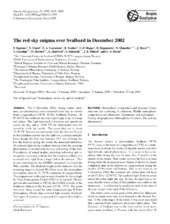The red-sky enigma over Svalbard in December 2002
Sigernes, Fred; Lloyd, N.; Lorentzen, Dag Arne; Neuber, R.; Hoppe, U.-P.; Degenstein, D.; Shumilov, N.; Moen, Jøran Idar; Gjessing, Yngvar; Havnes, Ove; Skartveit, Arvid; Raustein, Elmer; Ørbæk, J.B.; Deehr, CS
Peer reviewed, Journal article
Published version

Åpne
Permanent lenke
https://hdl.handle.net/1956/17203Utgivelsesdato
2005Metadata
Vis full innførselSamlinger
- Geophysical Institute [1228]
Originalversjon
https://doi.org/10.5194/angeo-23-1603-2005Sammendrag
On 6 December 2002, during winter darkness, an extraordinary event occurred in the sky, as viewed from Longyearbyen (78° N, 15° E), Svalbard, Norway. At 07:30 UT the southeast sky was surprisingly lit up in a deep red colour. The light increased in intensity and spread out across the sky, and at 10:00 UT the illumination was observed to reach the zenith. The event died out at about 12:30 UT. Spectral measurements from the Auroral Station in Adventdalen confirm that the light was scattered sunlight. Even though the Sun was between 11.8 and 14.6deg below the horizon during the event, the measured intensities of scattered light on the southern horizon from the scanning photometers coincided with the rise and setting of the Sun. Calculations of actual heights, including refraction and atmospheric screening, indicate that the event most likely was scattered solar light from a target below the horizon. This is also confirmed by the OSIRIS instrument on board the Odin satellite. The deduced height profile indicates that the scattering target is located 18–23km up in the stratosphere at a latitude close to 73–75° N, southeast of Longyearbyen. The temperatures in this region were found to be low enough for Polar Stratospheric Clouds (PSC) to be formed. The target was also identified as PSC by the LIDAR systems at the Koldewey Station in Ny-Ålesund (79° N, 12° E). The event was most likely caused by solar illuminated type II Polar Stratospheric Clouds that scattered light towards Svalbard. Two types of scenarios are presented to explain how light is scattered.
